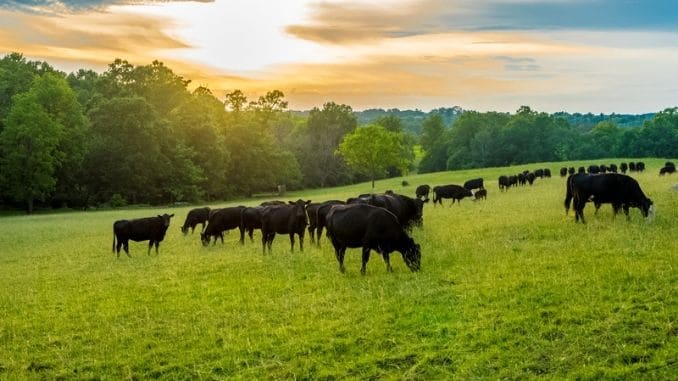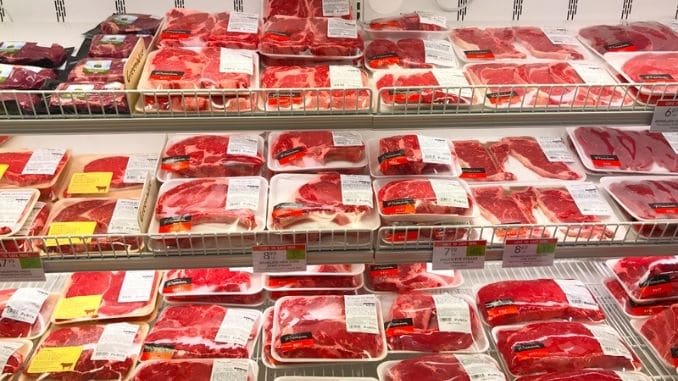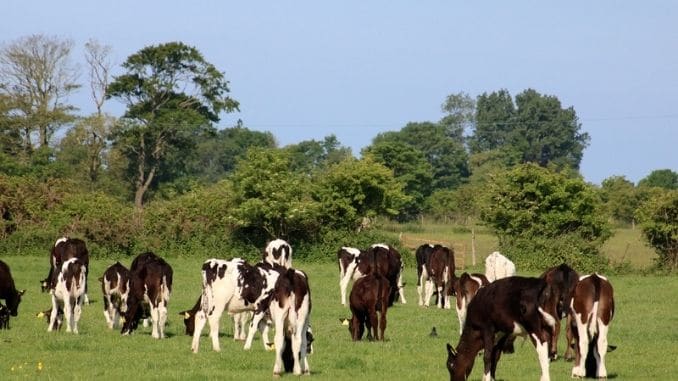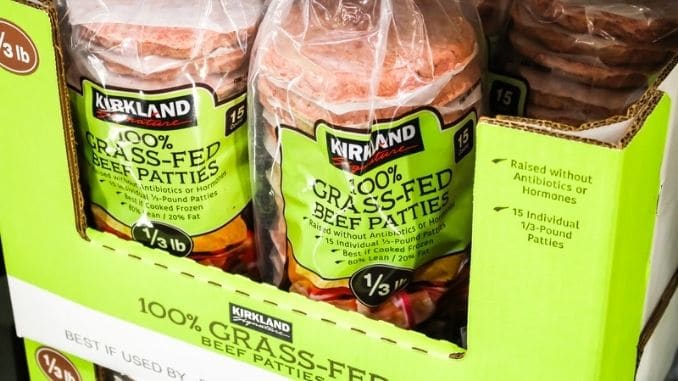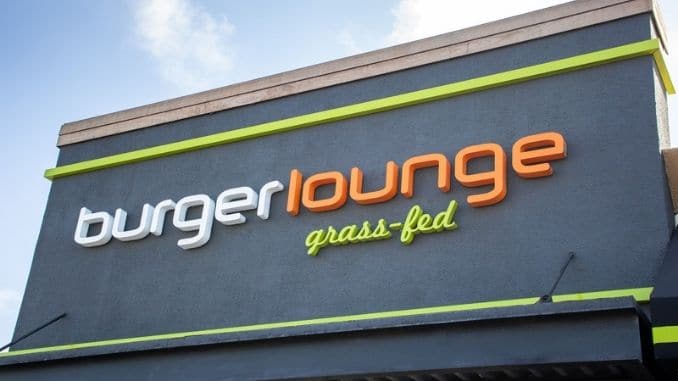
Have you seen beef labeled “Grass-fed” at the supermarket? How about “Grass-finished?” These labels sound almost the same. I did some research to learn the difference between grass-fed and grass-finished beef and was surprised at what I discovered. Here’s an easy-to-understand guide to the agricultural, nutritional, financial, culinary, and environmental differences between grass-fed and grass finished beef.
Agricultural Differences
Grass-fed beef: Agriculturally, there are a few key differences between cattle that are grass-fed and those that are grass-finished. The first several months of life for nearly every cow is somewhat natural. Calves are born in pastures; they enjoy a diet of either mother’s milk or a milk supplement. They also munch on grasses and other forage crops like green clover. At around six months or so, these young cows are weaned from the milk and they rely solely on greens as they grow into adolescence.
It’s normally at the end of the first year of the lives of most cows when grains are introduced into their diets. There is a process called backgrounding when cows are often sold to farmers who have the job of providing open green pastures for them as they are maturing. These farmers contain the growing cows and allow them to forage on grassy land that is otherwise unsuitable for farming crops.
During this backgrounding period, which typically lasts for two to six months, the cows are slowly transitioned from their natural green diets to mostly grains such as corn, soy, barley, and sorghum. Since grains are not at all natural for cows to eat, it’s necessary for the farmers to also administer feed additives containing antibiotics so that when the cows get sick from their new diet of grains, they will not die. Cows in backgrounding are being trained and conditioned for their future lives at the feedlot.
Once the backgrounded cows are grown and sturdy enough, they’ll spend the remaining four to six months of their lives in Animal Feeding Operations (AFOs) or Concentrated Animal Feeding Operations (CAFOs). AFO’s and CAFO’s are also known as feedlots. These are not natural places for animals to reside. According to A Greener World, an agricultural watchdog group out of Terrebonne, Oregon, “AFOs congregate animals, feed, manure, urine, dead animals and production operations on a small land area. The feed is brought to the animals rather than the animals grazing or otherwise seeking feed in pastures, fields, or on rangeland. AFOs confine animals for at least 45 days in a 12-month period and have no grass or other vegetation in the confinement area during the normal growing season.” The definition for a CAFO is the same. The main difference is that CAFO’s confine 1,000 cows or more at a time.
According to Big Picture Beef, a company that advocates for natural farming measures, “Forty percent of feedlot cattle are at facilities housing 32,000 head or more. Instead of grazing on pasture, they are confined to pens, each typically housing 100 to 125 animals, where the cattle stand in mud and manure.” Sadly, feedlot cattle spend the last few months of their lives packed together, standing on concrete slabs in inches of their own waste, eating low-quality foods that make them fat and sick.
It is in these feedlots or AFO’s that nearly all cows are fattened up with cheap, high-calorie grains. According to the agricultural experts at 4-H, cows on feedlots often gain over four pounds each day. The vast majority of beef sold in supermarkets is from cattle that have endured rapid growth on feedlots. It is the low-quality grain fed to cows that gives factory-farmed beef a tender, fatty and juicy consistency.
Grass-finished beef: Agriculturally, the life cycle of grass finished cow is vastly different than that of a factory-farmed animal. Cattle that are raised up to be 100 percent grass-fed and finished experience a more natural upbringing.
Grass-finished calves are born out in a pasture and are kept safe by their mothers. Generally, they stay close to their mothers and nurse for several months while they transition to a diet of grasses and forage crops. They graze throughout most of their days and mingle with other cattle.
At certain periods in development, these exclusively grass-fed cattle may be moved into a new pasture of fresh green grass, but even that is done in a humane fashion. These cows aren’t packed into stalls and made to stand and eat. They graze naturally throughout their days and grow at a natural rate.
Grass-fed cows are not treated with routine antibiotics to compensate for the grain byproducts. They rarely suffer the illnesses found in more conventional factory farming operations and consequently do not require regular medication or feed additives.
Nutritional Differences
Nutritionally, there are differences between grass-fed and grass finished beef. Nonetheless, it is worth noting that the conventional beef farming industry has taken great measures to minimize the nutritional superiority of 100 percent grass-fed and finished beef. In researching the matter, I found a slew of “studies” funded by the beef industry that found “little to no difference” in the nutritional properties of grass finished and grain-finished beef.
However, I kept digging. And I found some key nutritional differences between grass-fed and grass finished beef. I created a simple comparison chart with information that I sourced from the United States Department of Agriculture (USDA) Food Data Central website.
| Nutrition Facts per USDA | Ground Beef (grain-finished)
(100 grams) |
100% Grass Finished Ground Beef
(100 grams) |
| Calories | 247 | 198 |
| Protein | 17 grams | 19 grams |
| Fat total | 19 grams | 13 grams |
| Saturated fat | 7 grams | 5 grams |
| Monounsaturated fat | 8 grams | 4 grams |
| Iron | 2 mg | 2 mg |
| Magnesium | 17 mg | 19 mg |
| Cholesterol | 71 mg | 62 mg |
As you can see from looking at this very basic comparison, 100 percent grass finished ground beef is lower in calories. It is higher in protein, lower in saturated fat, monounsaturated fat, and overall fat than conventionally processed ground beef. It’s also a bit higher in magnesium and it is lower in cholesterol.
While these may seem like small nutritional differences, if you eat beef even just twice a week, switching to 100 percent grass-fed and finished beef will save you a little over 5,000 unwanted calories a year.
What’s more? Even though grass finished beef is a bit lower in fat than traditionally farmed, grain-finished beef, grass finished beef has more than twice the amount of Conjugated Linoleic Acid (CLA) as grain-finished beef. CLAs are essential fatty acids that have been linked to major health benefits. Recent studies have found that dietary CLAs lower the risk of certain types of cancer, prevent obesity and improve heart functioning.
Some studies have also shown that beef from 100 percent grass finished cattle is higher in omega 3 fatty acids than grain-finished beef. Similarly, grass finished beef has a higher antioxidant content than factory-farmed beef. All in all, grass finished beef is nutritionally superior to grain-finished beef.
Price Differences
Another difference between grain-finished and grass-finished beef is the price. By most estimations, 96-98 percent of American beef is grain-finished. It’s conventionally farmed beef from grain-fed cows that are filling most of the shelves at the supermarket. By and large, most restaurants are sourcing grain-fed beef as well. For this reason alone, beef from grain-fed cattle is considerably cheaper.
However, there are more reasons why grain-fed beef is less expensive. Exclusively grass-fed and finished cattle cost more to raise than grain-fed. These cows require more land for grazing and take more time to grow to the full market rate. It is far less expensive for farmers to buy up the cheapest, high-calorie grains available and feed it to their cattle for rapid weight gain.
In the United States, the government actually subsidizes grain crops for cattle farmers. According to Jenna Bardroff at One Green Planet, “Corn and soy are protein-rich food bases that cause animals to quickly reach market weight and are much cheaper than other food options – due to government subsidies. In the United States, 47 percent of soy and 60 percent of corn is used for livestock consumption.” Government subsidies and the relative effectiveness of high-calorie grains for producing heavier cows, make grain feeding a much more desirable option for most cattle farmers.
Consequently, the price of grass-finished beef is higher than conventionally farmed, grain-fed beef. When buying 100 percent grass-fed, grass-finished beef, you’ll likely pay around $3 per pound more. However, some grass-finished beef fans have shared that there is much less fat in the grass-finished meat they buy, which means less fat cooks off in the pan and they get more actual meat per pound. Either way, grass-finished beef will cost you more than grain-finished at the meat counter.
Flavor and Culinary Differences
In the area of flavor, most people who try grass-finished and grain-finished beef side-by-side, enjoy the flavor of grass-finished beef much more than conventionally processed beef. However, due to its unique texture and composition, grass-finished beef is not cooked in the same way as factory-farmed beef. According to Jess Ostlund at Adena Farms, “The truth is, grass-fed beef does need a little more care during the cooking process. Grass-fed, grass-finished beef is leaner than grain-fed and this results in slightly different cooking times.”
Ostlund goes on to recommend allowing your grass-finished beef to come to room temperature before you cook it. She also advises her customers to preheat their grills, ovens, or pans prior to cooking. And she instructs chefs to season and salts the meat just before cooking it. Finally, Ostlund recommends cooking grass-finished beef at lower temperatures and for less time than grain-finished meat. It’s easy to overcook grass-finished beef if you treat it like factory-farmed beef.
Environmental Differences
From an environmental perspective, raising grass-finished cattle is more sustainable and better for the earth. One of the farmers over at Acabonac Farms said, “A study by the National Trust in the United Kingdom found that ranches which produce 100 percent grass-fed cattle reduced greenhouse gas emissions. They also increase food security by using marginal land (land not used for intensive crop production) to create healthy food.”
When we are raising animals the way they were created to be raised, feeding them a diet that is naturally ideal for them and farming them in a humane
What to Look for on the Label
Because all cows are fed grass during their first years of life, any beef label can boast, “Grass-fed.” Of course, we know better than to trust a broad claim like that. When you’re looking to buy 100% grass-fed and grass-finished beef at the market, take time to examine the label closely.
Look for statements like, “100% grass-fed,” or “Grass-finished beef.” There are also a couple of certifications that are helpful. One certification is “PCO 100% Grassfed.” PCO stands for Pennsylvania Certified Organic. Meat with this label will be 100 percent grass-fed and organic. This is a very high standard that’s optional for farmers.
Another label that means a great deal is “Certified Grassfed by A Greener World (AGW).” The AGW is an optional label that lets consumers know that the meat they are buying is from cows that have been exclusively grass-fed and were raised under humane conditions.
Some legitimately grass-finished cuts of beef will not have any certifications. Make sure to ask the butcher and fully read the label before you buy anything in question. It’s also sometimes helpful to visit the farm’s website and read up on their practices. If you can buy directly from a local rancher, that’s an even better option.
In conclusion, there are huge differences between grass-finished and grain-finished beef. According to our research, it seems that grass finished beef is superior to grain-finished in nutrition, sustainability, and overall flavor. If you enjoy eating red meat, and you haven’t yet sampled a grass-finished beef product, consider giving it a try soon.
Slim and heal your body safely and naturally. Learn more here.

